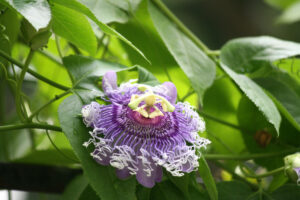Choose the Right Variety and Location
Select a variety of passionflower that is suitable for your climate. There is more than one variety of passionflower however passiflora incarnata is a native plant in the southeast United States and grows wild across that area and into Texas and Oklahoma as well. You may find volunteers in sunny areas along woodland edges and fences.
Find a spot in your garden or outdoor space that is sheltered from strong winds and full sun most of the day, with some partial shade in the hottest part of the afternoon.
Prepare and Plant
Before planting, make sure the soil is well-draining and rich in organic matter. Till any existing soil and add compost, manure or other organic matter to create a nutrient-rich bed of soil for your plant’s roots. Sandy or gravelly soils are preferred as they allow for better drainage, and clay soils should be amended with sand to improve drainage before planting the passion flower.
Plant your passionflower in a hole that is two times as wide and the same depth as the root ball of the plant, and fill with some soil amended with compost or manure. Water deeply to help settle the soil and create good contact with the roots.
Passionflower is a vine and will benefit from some sort of trellis. It can grow up to 30 feet so plan accordingly. However, passionflower is often found rambling along the ground perfectly happy, as well.
Care for Your Plant
Passion flowers benefit from regular watering, especially during the summer months when the temperatures are higher and rainfall is lower. Make sure to water deeply so that the roots can access moisture at least 6 inches below the surface until it is established. Once established it can tolerate drought.
Passionflowers are aided by regular fertilizing to produce blooms and lush foliage. Use a balanced fertilizer (10-10-10 or something similar) every two or three weeks during the growing season.
Pruning and Training Passionflower Vines
Passionflower is a fast-growing vine, so regular pruning is important to keep it under control. Prune the vine in late winter or early spring before new growth begins. Cut back any dead or damaged branches and thin out the tangled stems to make it easier for sunlight to reach all parts of the plant. Pruning young vines will encourage them to grow in the direction you want and to form a bushy shape.
Once your passion flower has reached its desired height, you can train the branches to climb trellises or arbors for a stunning display. Wrap flexible stems around trellis wires and secure them with plant ties or clips. This will give your passion flower even more room to grow.
Pest and Disease
Passionflower is generally free of serious pest or disease problems but can occasionally be affected by aphids, mealybugs, whiteflies or scale insects. Treat any pests or diseases with an appropriate insecticidal soap or fungicide, according to the directions on the product label. Monitor your passion flower regularly for signs of pests and diseases and treat them promptly if found.
Passionflower can also be susceptible to fungal diseases such as powdery mildew or root rot if left in soggy soil for too long. If you notice any discoloration or wilting of the leaves, remove affected areas to prevent it from spreading.
For the most part, though, passionflower is a carefree plant once established.
Growing Passionflower from Seeds
Passionflower can also be grown from seeds. Start by soaking the seeds in lukewarm water for 24 hours before planting. Some resources say you may want to nick the seeds before planting but honestly, they grow wild where I live so I have never done that. Plant the seeds in sandy, well-draining soil and lightly cover them with soil. Keep the soil moist and place in a warm spot with plenty of sunlight until they germinate, which usually happens within two weeks. Transplant the seedlings into larger pots and continue to care for as you would a mature plant.
Growing Passionflower from Cuttings
In addition to propagating passionflower from seed, you can also grow them from cuttings. Take a 4-6 inch cutting from the tips of the vines and remove any leaves from the lower half. Dip in a rooting hormone and place it in well-draining soil or a pot with damp sand or perlite. Make sure there is plenty of moisture and a warm spot with bright light. The cuttings should take root within 6-8 weeks. Transfer to larger pots once the roots are established and continue caring for as you would an adult plant. With proper care, passionflower can thrive indoors and outdoors!
Transplanting Passionflower from the Wild
Passionflower can also be transplanted from the wild, if it’s legal in your area. Make sure to choose a young plant with plenty of growth and no brown or dead leaves. Be very careful when digging around the roots as they are quite delicate. Plant in well-draining soil in an area that receives full sun or partial shade and water regularly. Once the plant is established, apply a balanced fertilizer every few months to encourage growth and flowering. With proper care, your transplanted passionflower should thrive!
Benefits of Passionflowers
Attract Pollinators
Passionflower vines are an excellent way of attracting pollinators such as bees and butterflies into your garden. These pollinators help keep the plant healthy by aiding in the spread of pollen from one flower to another. Plus, they provide a beautiful display of color and movement in your garden! With the right care, your passion flower vine can be a real showstopper.
Edible Fruit
Passionflowers typically bloom from late spring through mid-summer. It also produces edible fruits, called maypops or passion fruit, that are round and about the size of a hen’s egg. The fruit has a sweet and tangy flavor that can be enjoyed fresh or used in jams, jellies and beverages.
Winter Care
As winter approaches, cut back any dead or damaged vines and mulch around the base of the plant to help protect it from cold temperatures. If you live in an area where temperatures drop below freezing, cover the plant with a cloth or blanket to protect it from frost. Once temperatures rise above freezing, uncover and water the plant if needed. In cool climates, mulching can also help insulate soil during winter months. However in zones 7 and above they are perineal and should come back every year without added care. Nonetheless, in zone 7 we do sometimes get deeper freezes and you may want added protection.
Share the Beauty of Passion Flower
Once you have mastered growing passionflower, why not share it with a friend? Give them one of your propagated vines as a gift or offer to help them start their own garden! Passion flowers are an amazing addition to any garden, so it will be sure to bring a smile to their face.

Get Creative
Passionflower vines are also very versatile plants and can be used in a variety of ways! Consider creating a trellis or arbor to show off its beauty, or use it as an ornamental border along your garden path. You can even create stunning wall hangings or wreaths with the flowers and foliage for a unique decor piece. No matter how you use it, passion flower vines are sure to bring a touch of beauty and elegance to your garden!
Have Fun with Your Passion Flower Vines
Growing and caring for passion flower vines can be a rewarding experience that brings joy for years to come. So don’t forget to take the time to enjoy them! Spend some time admiring the beauty of the flowers, or take a moment to sit and watch as pollinators flit from one blossom to another. No matter what you choose to do, you are sure to find pleasure in your passion flower vines.
If you want to learn about being more self-sufficient check out the book below. I love this series of books. This is an affilate link.
For more on self-sufficient living click here.
Conclusion
Whether you grow your passion flower vine for its flowers, its fruit, or just for the beauty of its foliage, you are sure to find something to love about it. Growing passion flowers is a great way to add color, beauty, and interest to your garden. Its unique flowers are sure to draw attention and admiration from all who see them! So why not give growing passion flower vines a try today? Enjoy the beauty of this lovely plant and share it with others!
For more on gardening click here.
For information on the medicinal properties of passionflower click here.


